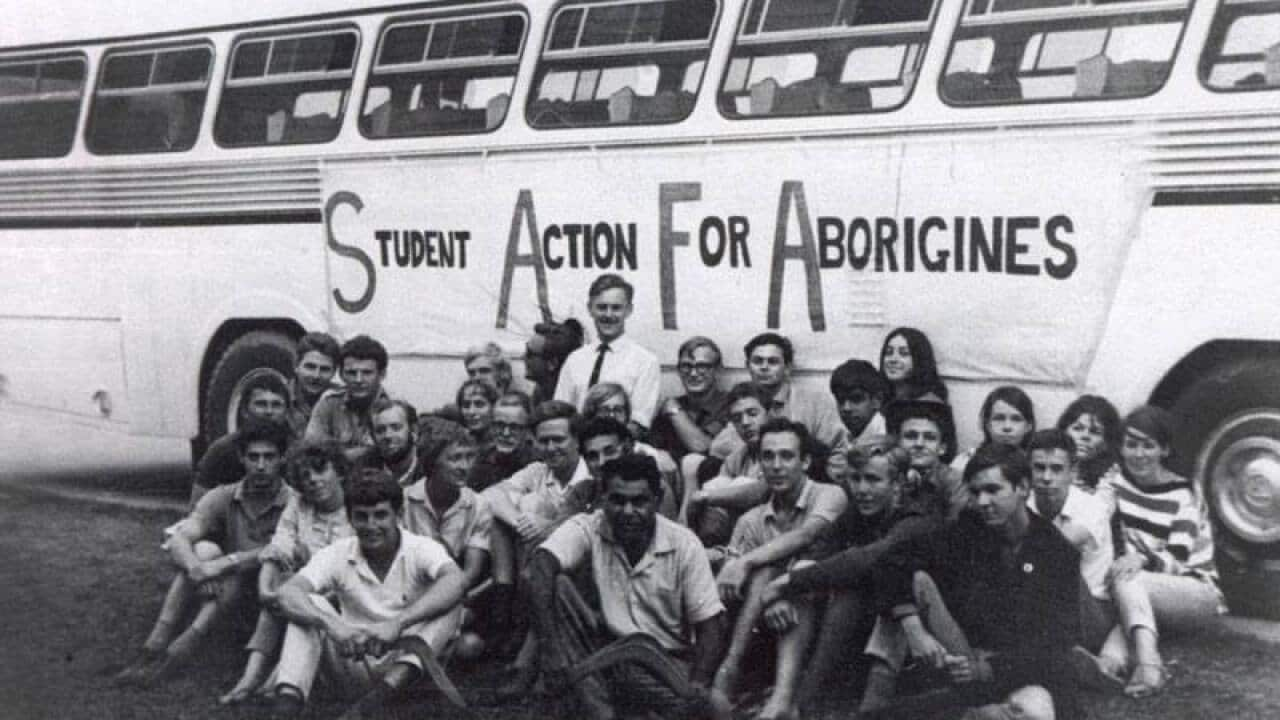What was the Freedom Ride?
A group of students from the University of Sydney, inspired by the United States 1961 Freedom Rides, got on a bus on 12 February, 1965 and toured through regional towns such as Walgett, Gulargambone, Kempsey, Bowraville and Moree to show wider Australia the experience of Aboriginal Australians.
These students - who were known as the Student Action for Aborigines (SAFA) and led by Arrernte man Charles Perkins from Alice Springs - recorded acts of racism against Aboriginal people and broadcast them to media around the country.
Where did they go?
Walgett RSL Club
The Freedom Riders protested outside the Walgett RSL Club on 15 February 1965 because they had been told the club was not permitting entry for Indigenous ex-servicemen. They held signs that read: "Good enough for Tobruk - why not Walgett RSL?" and protested a womenswear store forbidding Indigenous women from trying on dresses. Their presence was felt by the community and attempts were made to run the bus off the road as they left Walgett.
Moree Baths
The students travelled to Moree, NSW, and marched to Moree swimming pool to picket prohibiting Indigenous people from swimming in the pool.
Fifty years ago, the student action group protested outside the Moree Council Chambers before taking a group of Aboriginal children into the baths to break the racist practice.
Bowraville Picture Theatre
The group stopped off at Bowraville, in the mid north coast hinterland, because they wanted to draw attention to segregation practiced by management at the Bowraville Picture Theatre. They picketed the theatre for demanding that Indigenous people buy their tickets separately from non-Indigenous people, enter the theatre through a side entrance after a show had begun, and sit in secondary seating.

The bus that is retracing the journey of the 1965 Freedom Riders departs the University of Sydney this morning. (NITV)
Who were the Freedom Riders?
Charles Perkins
Arrernte Alice Springs man Charles Perkins led the 1965 Freedom Ride. Perkins was one of the first Indigenous Australians to graduate from tertiary education and went on to be appointed the head of the government’s Department of Aboriginal Affairs in 1984. He became a leader at the national level for Indigenous Australians. Perkins passed away in 2000 and is referred to by his mourning name, Kumantjayi Perkins.
The Hon. Jim Spigelman
Jim Spigelman joined the Freedom Ride as an arts student. He filmed much of the action during the journey but this was not broadcast until 1978. He went on to serve as senior advisor and principal private secretary to Prime Minister Gough Whitlam between 1972-1975 and by 1998, Spigelman was appointed chief justice of the Supreme Court of New South Wales. He is currently the Australian Broadcasting Corporation chairperson, a position he has held since 2012.
Professor Ann Curthoys
Ann Curthoys specialises in Australian history. She documented her experience of being a 1965 Freedom Rider , which has since been published on the Australian Institute of Aboriginal and Torres Strait Islander Studies (AIATSIS) website.
Darce Cassidy
Darce Cassidy was an arts student and ABC journalist at the time he took part in the journey. He produced a radio documentary of the experience which he titled "The Australian Freedom Rides".
What was their legacy?
The legacy of the Freedom Ride was that it gave many Australians a greater awareness about the struggle of our First Peoples for equality and sparked debate about Indigenous affairs of the day, leading to the 1967 referendum. The referendum resulted in two amendments to the Constitution of the Commonwealth of Australia.
First amendment: In respect to the power of the federal government to make laws, which previously read: “The people of any race, other than the Aboriginal race in any State, for whom it is deemed necessary to make special laws' (Commonwealth Constitution Section 51, paragraph xxvi), the clause “Other than the Aboriginal race in any State” was removed which gave the government the ability to make laws for Indigenous Australians.
Second amendment: The provision in the Constitution that stated that Indigenous people would not be included in Australia’s census: "In reckoning the numbers of the people of the Commonwealth, or of a state or other part of the Commonwealth, Aboriginal natives shall not be counted", was removed (Section 127). This was regarded by many as a significant symbolic gesture to break down barriers between non-Indigenous and Indigenous Australians.










